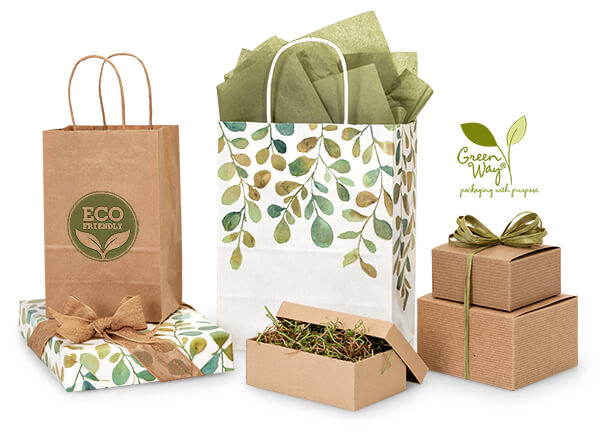The Importance of Using Environmentally Friendly Packaging
The materials you use for packaging are critical. The overuse of plastics and non-recyclable or biodegradable packaging has led to a poor perception of packaging in general among many customers.
When customers get your goods, they want it to be packed ethically, using non-toxic, recyclable, and biodegradable materials that will not add to the sustainability concerns that our world is experiencing.
As these concerns become more essential to the contemporary, well-informed customer, they should also become more vital to your brand and company.
Begin by evaluating your present packaging solution and determining where adjustments may be made to include more eco-friendly packaging materials into your future package design.
Eco-Friendly Packaging Solutions Come in a Variety of Forms
There are a variety of ECO Friendly Packaging options available to guarantee that your items are well-presented on the shelf and well-protected in transportation.
Depending on the specific demands of your business, consumer, or product, each of these materials may be utilised in a number of ways.
Choosing the correct packaging material can assist your firm in reducing its carbon footprint, improving its brand image, increasing sustainability, and improving customer happiness, all of which will result in a healthier bottom line for your company.
Corrugated Boxes
This packaging solution is very adaptable and may be used to package a wide range of items from a wide range of sectors.
Corrugated boxes are the perfect packaging option for business owners who want to make a genuine commitment to minimising their company's carbon footprint in the future owing to the variety of advantages this packaging solution can give.
Corrugated cardboard boxes are used to carry more than 90% of items in the United States.
Corrugated Boxes are the most abundant single product in municipal solid waste (MSW), accounting for more than 33.3 million tonnes in 2018. They are also the most commonly recycled.
In 2018, 32.1 million tonnes of corrugated boxes were recycled out of a total of 33.9 million tonnes of paper and paperboard recycling in the United States, resulting in a 96.5 percent recycling rate
In 2018, 230,000 tonnes of corrugated boxes were burned, with 940,000 tonnes ending up in landfills.
Corrugated cardboard boxes are not only recycled, but they are also reused much more often than single-use cardboard.
Packaging Made of Paper and Cardboard
In North America and other areas of the globe, different types of paper and cardboard packaging are also commonly used and recycled.
Paper and paperboard are excellent materials for a broad range of applications, including folding cartons, wrapping, paperboard boxes, gable-top cartons, liquid food aseptic cartons, and a variety of sack and bag kinds.
While corrugated cardboard boxes account for a large amount of MSW created, the US EPA discovered that other forms of paper packaging materials are also included in the recycling system. In fact, it is expected that 1.8 million tonnes of different paper packaging materials were recycled in 2018.
In the United States, paper and paperboard packaging account for 75% of all packaging materials collected for recycling.
In 2018, the total recycling rate for paper and paperboard packaging was 80.9 percent.
In 2018, 3.7 percent of these materials were combusted for energy recovery.
15.4 percent of this garbage was disposed of in landfills in the United States.
Other paper packaging, such as sacks, bags, and cartons, is often recycled as mixed papers.
Packaging that is flexible
Flexible packaging may provide a variety of advantages to company owners looking to lessen their environmental impact. According to the Flexible Packaging Association (FPA), the flexible packaging category is growing the fastest in the United States and globally.
Although the FPA has said that many existing flexible packaging materials are not yet recyclable, these solutions may assist a firm minimise its carbon impact.
Flexible packaging uses less material than rigid PET or glass packaging, making it a more environmentally friendly material. For example, 2.5lbs of flexible packaging is required to pack 100lbs of liquids, but 84lbs of glass is required for the same purpose.
Flexible packaging uses less resources, including valuable commodities such as fossil fuels and water. Coffee beans wrapped in steel, for example, consume 1,605 percent more water than a flexible pouch, while rigid pail packing uses 1,429 percent more fossil fuels than its flexible packaging counterpart.
Flexible packaging takes up less storage and transit area, which reduces CO2 emissions.
Flexible packaging extends the shelf life of food, lowering the amount of waste generated in stores.
Custom Mask Boxes takes up less area in landfills, accounting for just 4% of packing materials in landfills.
What Strategies Are Effective, and What Can Your Company Do?
With environmental problems becoming increasingly important to customers all around the globe, it's critical that you adopt an ecologically responsible approach to your packaging in the future.
Recycling technology and methods are constantly improving, and more recycled materials are being incorporated into new goods as well as the materials in which they are packed.
As a company owner, you have the ability to be part of the solution rather than part of the issue.
Proactively minimizing your carbon footprint, supporting sustainable business procedures, and implementing eco-friendly packaging materials and solutions can guarantee that your brand is well-received by customers.
The following are some tried-and-true tactics for making a difference in your local business community.






Great tips regrading catering packaging. You provided the best information which helps us a lot. Thanks for sharing the wonderful information.
ReplyDelete